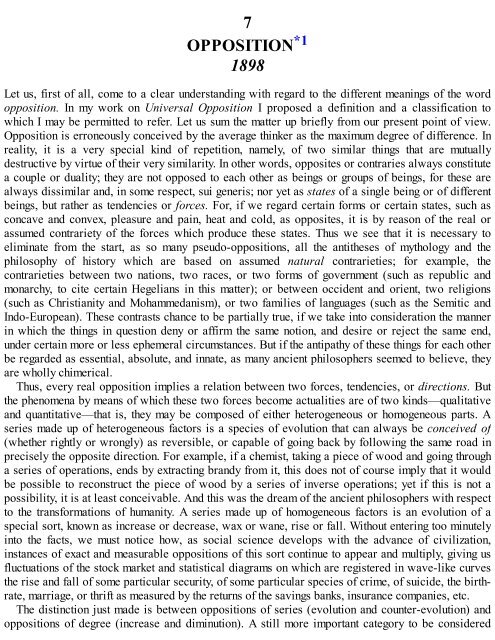3658925934
Create successful ePaper yourself
Turn your PDF publications into a flip-book with our unique Google optimized e-Paper software.
7<br />
OPPOSITION *1<br />
1898<br />
Let us, first of all, come to a clear understanding with regard to the different meanings of the word<br />
opposition. In my work on Universal Opposition I proposed a definition and a classification to<br />
which I may be permitted to refer. Let us sum the matter up briefly from our present point of view.<br />
Opposition is erroneously conceived by the average thinker as the maximum degree of difference. In<br />
reality, it is a very special kind of repetition, namely, of two similar things that are mutually<br />
destructive by virtue of their very similarity. In other words, opposites or contraries always constitute<br />
a couple or duality; they are not opposed to each other as beings or groups of beings, for these are<br />
always dissimilar and, in some respect, sui generis; nor yet as states of a single being or of different<br />
beings, but rather as tendencies or forces. For, if we regard certain forms or certain states, such as<br />
concave and convex, pleasure and pain, heat and cold, as opposites, it is by reason of the real or<br />
assumed contrariety of the forces which produce these states. Thus we see that it is necessary to<br />
eliminate from the start, as so many pseudo-oppositions, all the antitheses of mythology and the<br />
philosophy of history which are based on assumed natural contrarieties; for example, the<br />
contrarieties between two nations, two races, or two forms of government (such as republic and<br />
monarchy, to cite certain Hegelians in this matter); or between occident and orient, two religions<br />
(such as Christianity and Mohammedanism), or two families of languages (such as the Semitic and<br />
Indo-European). These contrasts chance to be partially true, if we take into consideration the manner<br />
in which the things in question deny or affirm the same notion, and desire or reject the same end,<br />
under certain more or less ephemeral circumstances. But if the antipathy of these things for each other<br />
be regarded as essential, absolute, and innate, as many ancient philosophers seemed to believe, they<br />
are wholly chimerical.<br />
Thus, every real opposition implies a relation between two forces, tendencies, or directions. But<br />
the phenomena by means of which these two forces become actualities are of two kinds—qualitative<br />
and quantitative—that is, they may be composed of either heterogeneous or homogeneous parts. A<br />
series made up of heterogeneous factors is a species of evolution that can always be conceived of<br />
(whether rightly or wrongly) as reversible, or capable of going back by following the same road in<br />
precisely the opposite direction. For example, if a chemist, taking a piece of wood and going through<br />
a series of operations, ends by extracting brandy from it, this does not of course imply that it would<br />
be possible to reconstruct the piece of wood by a series of inverse operations; yet if this is not a<br />
possibility, it is at least conceivable. And this was the dream of the ancient philosophers with respect<br />
to the transformations of humanity. A series made up of homogeneous factors is an evolution of a<br />
special sort, known as increase or decrease, wax or wane, rise or fall. Without entering too minutely<br />
into the facts, we must notice how, as social science develops with the advance of civilization,<br />
instances of exact and measurable oppositions of this sort continue to appear and multiply, giving us<br />
fluctuations of the stock market and statistical diagrams on which are registered in wave-like curves<br />
the rise and fall of some particular security, of some particular species of crime, of suicide, the birthrate,<br />
marriage, or thrift as measured by the returns of the savings banks, insurance companies, etc.<br />
The distinction just made is between oppositions of series (evolution and counter-evolution) and<br />
oppositions of degree (increase and diminution). A still more important category to be considered









![Genki - An Integrated Course in Elementary Japanese II [Second Edition] (2011), WITH PDF BOOKMARKS!](https://img.yumpu.com/58322134/1/180x260/genki-an-integrated-course-in-elementary-japanese-ii-second-edition-2011-with-pdf-bookmarks.jpg?quality=85)
![Genki - An Integrated Course in Elementary Japanese I [Second Edition] (2011), WITH PDF BOOKMARKS!](https://img.yumpu.com/58322120/1/182x260/genki-an-integrated-course-in-elementary-japanese-i-second-edition-2011-with-pdf-bookmarks.jpg?quality=85)





